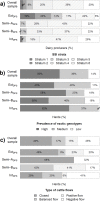Dairy production in an urbanizing environment-Typology and linkages in the megacity of Bengaluru, India
- PMID: 34383791
- PMCID: PMC8360525
- DOI: 10.1371/journal.pone.0255791
Dairy production in an urbanizing environment-Typology and linkages in the megacity of Bengaluru, India
Abstract
Urbanization is a main driver of agricultural transition in the Global South but how it shapes trends of intensification or extensification is not yet well understood. The Indian megacity of Bengaluru combines rapid urbanization with a high demand for dairy products, which is partly supplied by urban and peri-urban dairy producers. To study the impacts of urbanization on dairy production and to identify key features of dairy production systems across Bengaluru's rural-urban interface, 337 dairy producers were surveyed on the socio-economic profile of their household, their dairy herd and management, resources availability and, in- and output markets. A two-step cluster analysis identified four spatially explicit dairy production systems based on urbanization level of their neighborhood, reliance on self-cultivated forages, pasture use, cattle in- and outflow and share of specialized dairy genotypes. The most extensive dairy production system, common to the whole rural-urban interface, utilized publicly available feed resources and pasture grounds rather than to cultivate forages. In rural areas, two semi-intensive and one intensive dairy production systems relying on self-cultivation of forage with or without pasture further distinguished themselves by their herd and breeding management. In rural areas, the village's dairy cooperative, which also provided access to inputs such as exotic genotype through artificial insemination, concentrate feeds and health care, was often the only marketing channel available to dairy producers, irrespective of the dairy production system to which they belonged. In urban areas, milk was mostly sold through direct marketing or a middleman. Despite rapidly progressing urbanization and a population of 10 million, Bengaluru's dairy sector still relies on small-scale family dairy farms. Shifts in resources availability, such as land and labor, are potential drivers of market-oriented intensification but also extensification of dairy production in an urbanizing environment.
Conflict of interest statement
The authors have declared that no competing interests exist.
Figures







Similar articles
-
Urbanisation threats to dairy cattle health: Insights from Greater Bengaluru, India.Trop Anim Health Prod. 2023 Oct 5;55(5):350. doi: 10.1007/s11250-023-03737-7. Trop Anim Health Prod. 2023. PMID: 37796345 Free PMC article.
-
Socioeconomic characteristics of urban and peri-urban dairy production systems in the North western Ethiopian highlands.Trop Anim Health Prod. 2011 Aug;43(6):1145-52. doi: 10.1007/s11250-011-9815-3. Epub 2011 Mar 31. Trop Anim Health Prod. 2011. PMID: 21448780
-
Dairy intensification in developing countries: effects of market quality on farm-level feeding and breeding practices.Animal. 2013 Dec;7(12):2054-62. doi: 10.1017/S1751731113001602. Epub 2013 Oct 8. Animal. 2013. PMID: 24103418 Free PMC article.
-
Review: Genetic selection of high-yielding dairy cattle toward sustainable farming systems in a rapidly changing world.Animal. 2021 Dec;15 Suppl 1:100292. doi: 10.1016/j.animal.2021.100292. Epub 2021 Jul 20. Animal. 2021. PMID: 34294547 Review.
-
MILK Symposium review: Identifying constraints, opportunities, and best practices for improving milk production in market-oriented dairy farms in Sri Lanka.J Dairy Sci. 2020 Nov;103(11):9774-9790. doi: 10.3168/jds.2020-18305. J Dairy Sci. 2020. PMID: 33076188 Review.
Cited by
-
Urbanisation threats to dairy cattle health: Insights from Greater Bengaluru, India.Trop Anim Health Prod. 2023 Oct 5;55(5):350. doi: 10.1007/s11250-023-03737-7. Trop Anim Health Prod. 2023. PMID: 37796345 Free PMC article.
-
Selective Sweeps in Cattle Genomes in Response to the Influence of Urbanization and Environmental Contamination.Genes (Basel). 2023 Nov 15;14(11):2083. doi: 10.3390/genes14112083. Genes (Basel). 2023. PMID: 38003026 Free PMC article.
References
-
- Tacoli C. The links between urban and rural development. Environment & Urbanization 2003:3–12.
-
- Francis C, Lieblein G, Steinsholt H, Breland TA, Helenius J, Sriskandarajah N et al.. Food systems and environment: building positive rural-urban linkages. Human Ecology Review 2005:60–71. https://www.jstor.org/stable/24707501.
-
- Sundkvist Å, Milestad R, Jansson A. On the importance of tightening feedback loops for sustainable development of food systems. Food Policy 2005; 30(2):224–39 10.1016/j.foodpol.2005.02.003. - DOI
Publication types
MeSH terms
LinkOut - more resources
Full Text Sources

